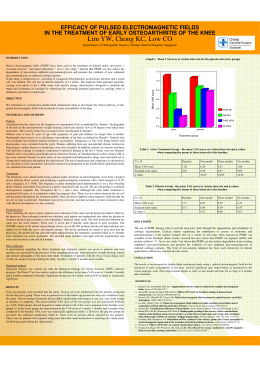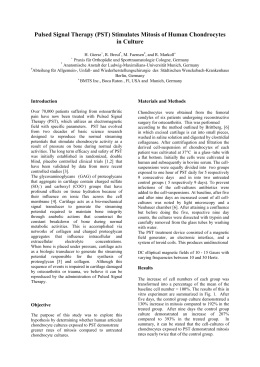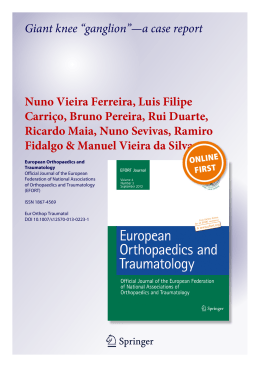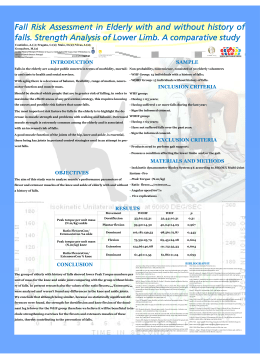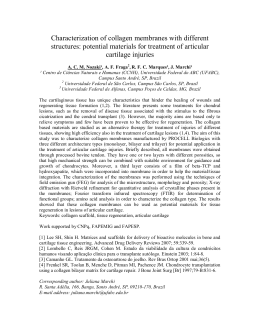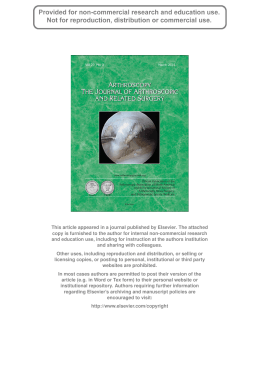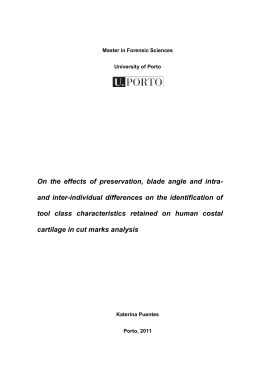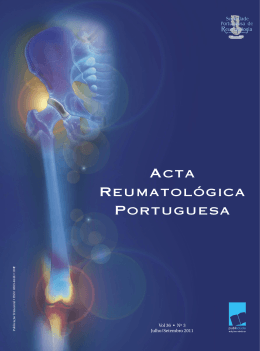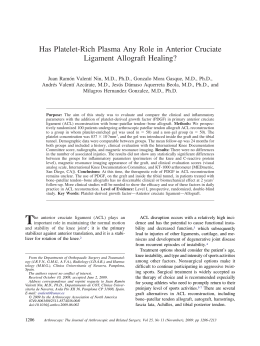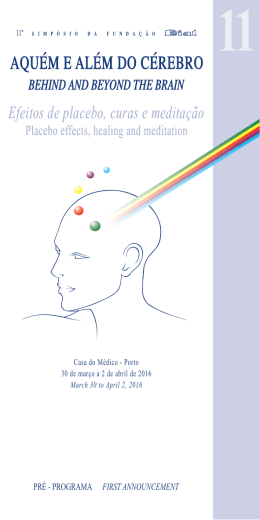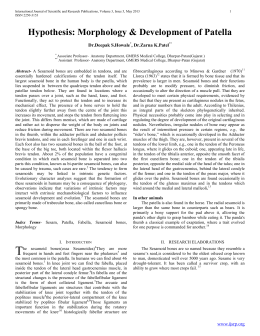REVIEW Chondroprotective agents: are we being too dogmatic? Gustavo Constantino de Campos Osteometabolic Group, Institute of Orthopedics and Traumatology, Faculdade de Medicina, Universidade de São Paulo, São Paulo, Brazil Recent major guidelines to osteoarthritis treatment have ceased to recommend the use of chondroprotective drugs; this new standing is based on new data, but comes mostly from a reassessment of existing information through methods of evidence-based medicine; these were more rigorous, with significant changes in the search and inclusion criteria, minimum follow-up requirement and the use of the concept of minimum clinically important improvement. However, currently available data includes a wealth of high quality studies demonstrating long term symptomatic relief and additional benefits such as global efficacy that match results described for non steroidal anti-inflammatory drugs. It is an undisputed concept that osteoarthritis should be managed as an integrated package of care rather than through single treatments, ministered alone or in succession. Thus, when osteoarthritis is in fact managed through any single treatment in order to conduct a controlled trial, it logically follows that it would be difficult to produce significant symptomatic improvements. Moreover, it is well established that positive placebo effects are a significant entity in osteoarthritis research. Therefore, it seems unreasonable to disqualify statistically significant results favoring chondroprotective agents used as monotherapy vs. a powerful placebo and consider them to be “not clinically relevant”. We performed a review of the literature and found high quality data showing that chondroprotective agents are safe, effective and decrease the use of non-steroidal anti-inflammatory agents. We therefore suggest that recent guidelines are overly dogmatic. KEYWORDS: Osteoarthritis; chondroprotective drugs; treatment. de Campos GC. Chondroprotective agents: are we being too dogmatic?. MEDICALEXPRESS. 2014 Aug;1(4):211-213. Received for publication on June 1 2014; First review completed on June 14 2014; Accepted for publication on June 23, 2014 E-mail: [email protected] B INTRODUCTION Over the last two decades there has been great interest in the use of chondroprotective agents for osteoarthritis (OA) treatment, a promising field, with over five hundred reported studies. However, recently published major OA guidelines1-3 ceased to recommend the use of such drugs to treat OA, based on new data, but mostly reassessing existing information through methods of evidence-based medicine that were more rigorous, with significant changes in the search inclusion criteria, minimum follow-up requirement and the use of the concept of minimum clinically important improvement. Undoubtedly, scientific evidence relating to the capacity of chondroprotective drugs to modify OA progression is very limited. Thus, to apply the expression “diseasemodifying osteoarthritis drug” to such chondroprotective agents would be an overstatement. However, a good many high quality studies show long term symptomatic relief and additional benefits of these agents, including global efficacy similar to that non steroid anti-inflammatory drugs (NSAIDs) and a carry-over effect (i.e., an effect that lasts for months even after treatment suppression) with the use DOI: 10.5935/MedicalExpress.2014.04.10 of chondroprotective agents. The slow onset of action makes it more appropriate to use the expression “symptomatic slow acting drugs for osteoarthritis” when referring to such agents. Symptomatic Slow Acting Drugs for OA – What about them? Nutraceuticals. Nutraceutical is a portmanteau of the words “nutrition” and “pharmaceutical” which has come into general use. The use of chondroitin sulphate and glucosamine as well as the relevance of their clinical efficacy is constantly under debate. A recent meta-analysis concluded that there is no structural modifying effect of these agents based upon trials using joint space narrowing as a clinical end point4. Other meta-analyses5, including two trials, reported small to moderate protective effects of glucosamine sulphate on minimum joint space narrowing after 3 years in knee OA. This was in accordance with the first high quality Cochrane analysis of glucosamine treatment in OA6. Data relating to a recently published trial7 indicate that glucosamine sulphate can prevent total knee replacement. Five systematic reviews examined the efficacy of chondroitin for knee OA. Results differed regarding symptom relief, with four4,5,8,9 finding no significant benefit of chondroitin over placebo for pain, while one10 finds a Copyright q 2014 MEDICALEXPRESS. This is an open access article distributed under the terms of the creative commons attribution Non-Commercial License (http://creativecommons.org/licenses/by-nc/3.0/) which permits unrestricted non-commercial use, distribution, and reproduction in any medium, provided the original work is properly cited. 211 Chondroprotective agents Gustavo Constantino de Campos large effect in favor of chondroitin, in that it produced a significant reduction in joint swelling and effusion during the GAIT study. Some findings suggest that a combination of glucosamine and chondroitin sulphate could be more efficient than either in isolation10,11,12. A 2-year follow-up randomized controlled trial demonstrated that the combination resulted in a statistically significant reduction of joint space narrowing compared to placebo while chondroitin sulphate or glucosamine alone were without effect11. The American College of Rheumatology conditionally recommends that patients with knee OA should not use the glucosamine and chondroitin sulphate combination1. The Osteoarthritis Research Society International recently released new guidelines3 that did not recommend the use of glucosamine and chondroitin sulphate. Despite the good quality of evidence, low risk score and good effect size, the expert panel’s vote resulted in “uncertain” recommendation for symptom relief and “inadequate” recommendation for disease modification. Collagen Hydrosylate is obtained from collagenous tissues and contains high levels of glycine, proline and hydroxyproline, amino acids essential for the stability and regeneration of cartilage13. This product is generally recognized as a safe food ingredient by regulatory agencies. There are only three randomized controlled trials in the literature14-16. All of them showed that the use of a collagen hydrosylate dietary supplement improves joint pain, mobility and reduces the need for analgesic medication. Diacerein. Diacerein, differently from traditional nonsteroidal anti-inflammatory drugs, which inhibit prostaglandin synthesis is a slow acting, symptom modifying and perhaps disease-structure modifying drug for OA; its action occurs through interleukin-1 inhibition17. A Cochrane 2006 meta-analysis found a consistent benefit in pain improvement18. A 2010 systematic review and metaanalysis found statistically significant short-term benefits of diacerein for pain compared with placebo19. The authors suggested that diacerein might still be a safer alternative to non-steroidal anti-inflammatory drugs, which are associated with more severe adverse events. However, even this gold level evidence was insufficient to convince either the Osteoarthritis Society International or the American College of Rheumatology to recommend diacerein for OA treatment. Bisphosphonates. Bisphosphonates could be chondroprotective by hindering the bone remodeling process. Higher doses of risedronate (15 mg/day) did not reduce the signs or symptoms of OA, but did reduce the marker of cartilage degradation (CTX-II), which may contribute to attenuation of radiological progression of OA20. However, there is some evidence that bisphosphonates are effective in the treatment of OA pain21. Along with other bisphosphonates, zoledronic acid has shown chondroprotective effects in animal models of OA22 as well as a reduction in bone marrow edema and knee pain in a clinical trial23. Strontium Ranelate. Strontium ranelate, another drug used in the treatment of osteoporosis, may have anabolic effects on cartilage by directly promoting the formation of human cartilage matrix24. A three-year randomized controlled trial showed a chondroprotective effect and symptomatic improvement for knee OA25. Viscosupplementation. Viscosupplementation consists of the injection of exogenous hyaluronic acid into 212 MEDICALEXPRESS 2014 August;1(4):211-213 diarthrodial joints26. Clinical trials27-29 and metaanalyses30,31 have documented improvement in pain and function. Although previous Osteoarthritis Research Society International and American Academy of Orthopedic Surgeons guidelines supported viscosupplementation for knee osteoarthritis based on good quality studies32, recently published guidelines no longer recommend this modality of treatment. The Osteoarthritis Research Society 2014 guidelines panel votes were influenced by inconsistent conclusions between the meta-analyses and conflicting results regarding the safety of intra-articular hyaluronic acid injections3. In the American Academy guidelines it was stated that although statistically significant outcomes were seen in studies using higher molecular weight hyaluronic acid preparations, these were not clinically significant, based on a lack of minimal clinically important improvement2. B CONCLUSION Osteoarthritis should be managed through an integrated package of care rather than by single treatments, alone or in succession. Core measures (patient education, exercise and weight loss) should be combined with other non-pharmacological treatments, such as orthoses, walking aids, acupuncture, and with pharmacological treatments. Thus, it is only to be expected that when osteoarthritis is managed with one single treatment in order to conduct a controlled trial, it would be difficult to produce significant symptomatic improvements. Moreover, it is well established that placebo effect in osteoarthritis is huge, with effect sizes sometimes exceeding 0.4. Therefore, we are talking about drugs that even administered as monotherapeutic agents, and even compared to a powerful placebo effect, still obtain symptomatic relief with statistical significance in a large cohort of studies. To dismiss such findings as “not clinically relevant” seems unrighteous. Present day reports contain a large number of high quality data showing that chondroprotective agents are safe, effective and lead to decreases in the use of non-steroidal anti-inflammatory agents. It may thus be argued that recently edited international guidelines may be excessively dogmatic. B RESUMO “Guidelines” recentes produzidos por grandes entidades reumatológicas internacionais relativas ao tratamento da osteoartrite deixaram de recomendar o uso de medicamentos condroprotetores; estas novas recomendac ões baseiam-se em dados novos, mas principalmente em reavaliac ões de informac ões existentes, revisitadas através de métodos mais rigorosos de medicina baseada em evidências; estes novos métodos incluem mudanc as significativas nos critérios de busca e de inclusão, com follow-up mı́nimo e na utilizac ão do conceito de melhoria clinica minimamente importante. No entanto, dados atualmente disponı́veis incluem uma abundância de estudos de alta qualidade, demonstrando alı́vio sintomático a longo prazo e benefı́cios adicionais, tais como a eficácia global a nı́vel de resultados descritos para medicamentos anti-inflamatórios não esteroides. Por outro lado, é bem sabido que a osteoartrite deve ser gerida através de um pacote integrado de cuidados e não através de tratamentos, ministrados individualmente ou em sucessão. Por isso, quando a osteoartrite é tratada por meio de um MEDICALEXPRESS 2014 August;1(4):211-213 procedimento único, com a finalidade acadêmica de realizar um ensaio clı́nico controlado, não é de se esperar que aparec am melhorias sintomáticas significativas. Além disso, sabe-se também que efeitos placebo positivos são significativos na investigac ão de osteoartrite. Portanto, parece descabido exigir resultados clinicamente significativos, favorecendo agentes condroprotetores usados como monoterapia vs. um poderoso placebo e concluir que tais tratamentos “não são clinicamente relevantes”. Realizamos aqui uma revisão da literatura e encontramos uma abundância de dados de alta qualidade que mostram que os agentes condroprotetores são seguros, eficazes e capazes de diminuir o uso de agentes anti-inflamatórios não esteroides. Sugerimos, portanto, que as orientac ões recentes são excessivamente dogmáticas. B REFERENCES Chondroprotective agents Gustavo Constantino de Campos 14. 15. 16. 17. 18. 19. 1. Hochberg MC, Altman RD, April KT, Benkhalti M, Guyatt G, McGowan J, et al., American College of Rheumatology recommendations for the use of nonpharmacologic and pharmacologic therapies in osteoarthritis of the hand, hip, and knee. Arthritis Care Res (Hoboken). 2012;64(4):455-74. 2. Jevsevar DS. Treatment of osteoarthritis of the knee: evidence-based guideline, 2nd edition. J Am Acad Orthop Surg. 2013;21(9):571-6. 3. McAlindon TE, Bannuru RR, Sullivan MC, Arden NK, Berenbaum F, Bierma-Zeinstra SM, et al. OARSI guidelines for the non-surgical management of knee osteoarthritis. Osteoarthritis Cartilage. 2014;22 (3):363-88. 4. Wandel S, Juni P, Tendal B, Nuesch E, Villiger PM, Welton NJ, et al., Effects of glucosamine, chondroitin, or placebo in patients with osteoarthritis of hip or knee: network meta-analysis. BMJ. 2010;341:c4675. 5. Lee YH, Woo JH, Choi SJ, Ji JD, Song GG. Effect of glucosamine or chondroitin sulfate on the osteoarthritis progression: a meta-analysis. Rheumatol Int. 2010;30(3):357-63. 6. Towheed TE, Maxwell L, Anastassiades TP, Shea B, Houpt J, Robinson V, et al., Glucosamine therapy for treating osteoarthritis. Cochrane Database Syst Rev. 2005; (2):CD002946. 7. Bruyere O, Pavelka K, Rovati LC, Gatterova J, Giacovelli G, Olejarova M, et al., Total joint replacement after glucosamine sulphate treatment in knee osteoarthritis: results of a mean 8-year observation of patients from two previous 3-year, randomised, placebo-controlled trials. Osteoarthritis Cartilage. 2008;16(2):254-60. 8. Reichenbach S, Sterchi R, Scherer M, Trelle S, Burgi E, Burgi U, et al., Metaanalysis: chondroitin for osteoarthritis of the knee or hip. Ann Intern Med. 2007;146(8):580-90. 9. Hochberg MC, Zhan M, Langenberg P. The rate of decline of joint space width in patients with osteoarthritis of the knee: a systematic review and meta-analysis of randomized placebo-controlled trials of chondroitin sulfate. Curr Med Res Opin. 2008;24(11):3029-35. 10. Clegg DO, Reda DJ, Harris CL, Klein MA, O’Dell JR, Hooper MM, et al., Glucosamine, chondroitin sulfate, and the two in combination for painful knee osteoarthritis. N Engl J Med. 2006;354(8):795-808. 11. Fransen M, Agaliotis M, Nairn L, Votrubec M, Bridgett L, Su S, et al., Glucosamine and chondroitin for knee osteoarthritis: a double-blind randomised placebo-controlled clinical trial evaluating single and combination regimens. Ann Rheum Dis. 2014; doi: 10.1136/annrheumdis-2013-203954. [Epub ahead of print]. 12. Martel-Pelletier J, Roubille C, Abram F, et al., First-line analysis of the effects of treatment on progression of structural changes in knee osteoarthritis over 24 months: data from the osteoarthritis initiative progression cohort. Ann Rheum Dis. 2013; doi: 10.1136/annrheumdis2013-203906 [Epub ahead of print]. 13. Walrand S, Chiotelli E, Noirt F, Mwewa S, Lassel T. Consumption of a functional fermented milk containing collagen hydrolysate improves the 20. 21. 22. 23. 24. 25. 26. 27. 28. 29. 30. 31. 32. concentration of collagen-specific amino acids in plasma. J Agric Food Chem. 2008;56(17):7790-5. Clark KL, Sebastianelli W, Flechsenhar KR, Aukermann DF, Meza F, Millard RL, et al., 24-Week study on the use of collagen hydrolysate as a dietary supplement in athletes with activity-related joint pain. Curr Med Res Opin. 2008;24(5):1485-96. Zuckley L, Angelopoulou KM, Carpenter MR, McCarthy S, Meredith BA. Collagen Hydrolysate Improves Joint Function in Adults with Mild Symptoms of Osteoarthritis of the Knee. Am College of Sports Medicine. 2004;36(5):S153-4. Benito-Ruiz P, Camacho-Zambrano MM, Carrillo-Arcentales JN, Mestanza-Peralta MA, Vallejo-Flores CA, Vargas-Lopez SV, et al., A randomized controlled trial on the efficacy and safety of a food ingredient, collagen hydrolysate, for improving joint comfort. Int J Food Sci Nutr. 2009;60(Suppl 2):99-113. Martin G, Bogdanowicz P, Domagala F, Ficheux H, Pujol JP. Rhein inhibits interleukin-1 beta-induced activation of MEK/ERK pathway and DNA binding of NF-kappa B and AP-1 in chondrocytes cultured in hypoxia: a potential mechanism for its disease-modifying effect in osteoarthritis. Inflammation. 2003;27(4):233-46. Fidelix TS, Soares BG, Trevisani VF. Diacerein for osteoarthritis. Cochrane Database Syst Rev. 2006; (1):CD005117. Bartels EM, Bliddal H, Schondorff PK, Altman RD, Zhang W, Christensen R. Symptomatic efficacy and safety of diacerein in the treatment of osteoarthritis: a meta-analysis of randomized placebocontrolled trials. Osteoarthritis Cartilage. 2010;18(3):289-96. Iwamoto J, Takeda T, Sato Y, Matsumoto H. Effects of risedronate on osteoarthritis of the knee. Yonsei Med J. 2010;51(2):164-70. Davis AJ, Smith TO, Hing CB, Sofat N. Are bisphosphonates effective in the treatment of osteoarthritis pain? A meta-analysis and systematic review. PLoS One. 2013;8(9):e72714. Muehleman C, Green J, Williams JM, Kuettner KE, Thonar EJ, Sumner DR. The effect of bone remodeling inhibition by zoledronic acid in an animal model of cartilage matrix damage. Osteoarthritis Cartilage. 2002;10 (3):226-33. Laslett LL, Dore DA, Quinn SJ, Boon P, Ryan E, Winzenberg TM, et al. Zoledronic acid reduces knee pain and bone marrow lesions over 1 year: a randomised controlled trial. Ann Rheum Dis. 2012;71(8):1322-8. Henrotin Y, Labasse A, Zheng SX, Galais P, Tsouderos Y, Crielaard JM, et al., Strontium ranelate increases cartilage matrix formation. J Bone Miner Res. 2001;16(2):299-308. Reginster JY, Beaudart C, Neuprez A, Bruyere O. Strontium ranelate in the treatment of knee osteoarthritis: new insights and emerging clinical evidence. Ther Adv Musculoskelet Dis. 2013;5(5):268-76. de Rezende MU, de Campos GC. Viscosuplementac ão. Revista Brasileira de Ortopedia. 2012;47(2):160-4. Chevalier X, Jerosch J, Goupille P, van Dijk N, Luyten FP, Scott DL, et al., Single, intra-articular treatment with 6 ml hylan G-F 20 in patients with symptomatic primary osteoarthritis of the knee: a randomised, multicentre, double-blind, placebo controlled trial. Ann Rheum Dis. 2010;69 (1):113-9. de Campos GC, Rezende MU, Pailo AF, Frucchi R, Camargo OP. Adding triamcinolone improves viscosupplementation: a randomized clinical trial. Clin Orthop Relat Res. 2013;471(2):613-20. Zoboli AA, de Rezende MU, de Campos GC, Pasqualin T, Frucchi R, de Camargo OP. Prospective randomized clinical trial: single and weekly viscosupplementation. Acta Ortop Bras. 2013;21(5):271-5. Bannuru RR, Natov NS, Dasi UR, Schmid CH, McAlindon TE. Therapeutic trajectory following intra-articular hyaluronic acid injection in knee osteoarthritis – meta-analysis. Osteoarthritis Cartilage. 2011;19 (6):611-9. Bellamy N, Campbell J, Robinson V, Gee T, Bourne R, Wells G. Viscosupplementation for the treatment of osteoarthritis of the knee. Cochrane Database Syst Rev. 2006; (2):CD005321. Zhang W, Moskowitz RW, Nuki G, Abramson S, Altman RD, Arden N, et al., OARSI recommendations for the management of hip and knee osteoarthritis, Part II: OARSI evidence-based, expert consensus guidelines. Osteoarthritis Cartilage. 2008;16(2):137-62. 213
Download
